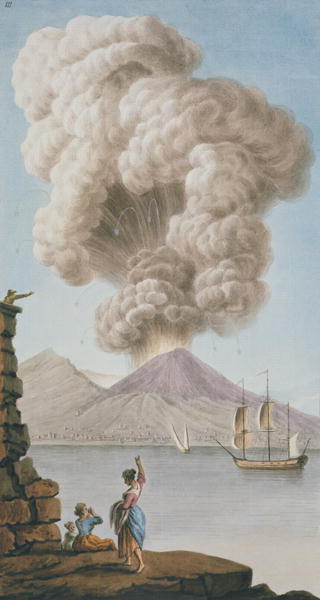Beginning Volcanology
Today, the beginnings of volcanology. The Honors College at the University of Houston presents this program about the machines that make our civilization run, and the people whose ingenuity created them.
How do you study a volcano without dying? That's a serious question. In 79 AD, Vesuvius claimed the life of the great ancient naturalist Pliny the Elder. Mount St. Helens killed volcanologist David Johnston in 1980. He died while manning an observation post sixmiles away! So where did the serious study of volcanoes begin? Who were its fearless pioneers?
The answer lies on the slopes of Vesuvius, which happens to be the only active volcano on the European mainland. When Vesuvius awoke from a long dormancy in the sixteenth century, it was then located in the Kingdom of Naples. Naples' political importance, its bustling port, and nearby archaeological sites made it a prime stop on the Grand Tour. This was the cultural journey required of every proper gentleman. In the 1700s, antiquarian and natural interests were not divided, so people flocked as much to the sites of Pompeii as to the eruptions of the increasingly active volcano.

Plate XXXVIII from Hamilton's Campi Phlegraei, showing him escorting the King and Queen of Naples to view a lava flow in 1771.
No one embodies the ideal of antiquarian and naturalist quite so well as Sir William Hamilton, a British diplomat long posted at the Bourbon Court of Naples. Hamilton actively surveyed the volcanic country not only of the Campania region, but also in Sicily and the Lipari islands. He collected numerous samples of volcanic materials, and sent them along with his observations to the Royal Society in London. His years of volcano watching finally bore fruit in print just as things were heating up in the American colonies. His folio publication Campi Phlegraei of 1776 was one of the most lavishly illustrated books of the eighteenth century, and a rarity treasured to this day.
Hamilton's importance lay chiefly in his dogged determination to observe. Theories of volcanic action abounded, but Hamilton was convinced that only the most detailed observations would bring any light on the matter. Climbing Vesuvius time after time during active eruptions, he risked his life to find out what secrets would emerge about the earth's true nature and age.

1779 Eruption of Vesuvius, from the 1779 Supplement to Campi Phlegraei
Sir William came to see the earth as immensely dynamic; volcanic activity was not a destructive force, but rather a powerfully creative one. His long stay in southern Italy taught him that much of the land he surveyed was the gift of countless centuries of volcanic eruption. His contention that basalt was a volcanic rock had wide-ranging implications. It was found in places not considered volcanic in northern Europe. Its presence suggested much of the north had also been formed by volcanoes.
In 1794, Vesuvius made another spectacular eruption, and Sir William, now 63 years old, performed his 68th ascent to make his observations at first hand. Realizing the vast forces were still beyond the scope of easy comprehension, he concluded with scientific modesty, "Let us then content ourselves with seeing, as well as we can, what we are permitted to see, and reason upon it to the best of our limited understandings, as well assured that whatever is, is right."
I'm Richard Hamilton Armstrong, at the University of Houston, where we're interested in the way inventive minds work.

Foldout illustration of the 1794 eruption of Vesuvius (Hamilton 1795)
Sources:
Primary:
Hamilton, William. Observations on Mount Vesuvius, Mount Etna, and other volcanos: in a series of letters addressed to the Royal Society ' to which are added, explanatory notes by the author. London, 1772.
Hamilton, William. Campi Phlegraei, Observations on the Volcanos of the Two Sicilies, As they have been communicated to the Royal Society of London. Naples, 1776.
Also, it's worth noting the book was sold for $59,673 at Christie's in 1993.
Hamilton, William. 'An Account of the Late Eruption of Mount Vesuvius, In a Letter from the Right Honourable Sir William Hamilton, K.B.F.R.S. to Sir Joseph Banks, Bart. P. R. S.' Philosophical Transactions of the Royal Society of London 85(1795): 73-116.
Secondary:
Darley, Gillian. Vesuvius. Harvard UP, 2012.
Jenkins, Ian and Kim Sloan. Vases and Volcanoes: Sir William Hamilton and His Collection. British Museum, 1996.
Sleep, Mark C. W. 'The Geological Work of Sir William Hamilton.' Proceedings of the Geological Association 80(1969):353-363.
Von der Th'sen, Joachim. 'Painting and the Rise of Volcanology: Sir William Hamilton's Campi Phlegraei.' Endeavour 23.3(1999): 106-109.
The notorious love triangle between Sir William, his second wife Emma, and Admiral Nelson has inspired many a novel. For one example, see Susan Sontag's The Volcano Lover (Farrar, Straus, Giroud, 1992).
This episode was first aired on August 1, 2012